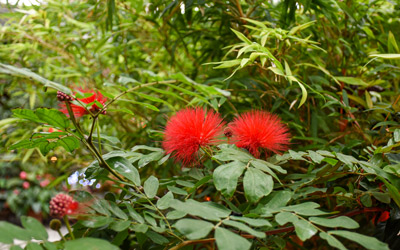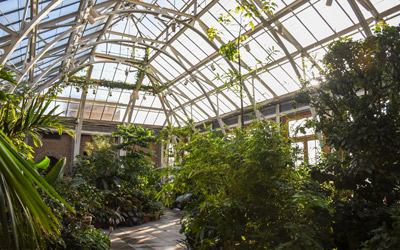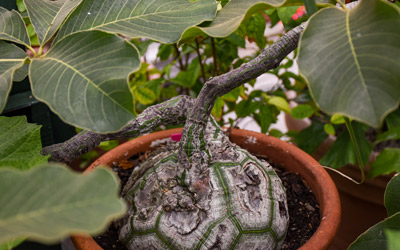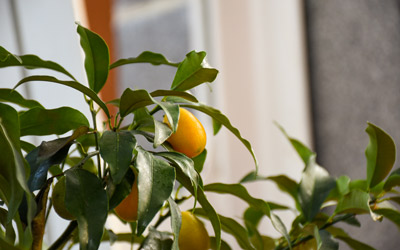By Liz Nye, New England Botanic Garden Staff
January 2023
Early each morning, long before visitors arrive, a member of the Garden’s “conservatory crew,” a team made up of horticulturist Meg Varnes and gardeners Brooke Harris and Greg Farrington, hoses down the stone floor of the Orangerie, one of New England Botanic Garden’s two conservatories. They aren’t cleaning. The horticulture team wets the floor to maintain humidity in a building designed to house tropical and subtropical plants. As the thermostat kicks on and sunlight filters in through the Orangerie’s glass ceiling and walls, the water on the floor evaporates into the air. The conservatory becomes a balmy oasis like no place else in New England in January.

A red powder puff tree (Calliandra haematocephala), endemic to Central and South America, blooms in the Orangerie this time of year. Its flowers burst from raspberry-like buds into fluffy, crimson orbs. In a nearby corner, a massive lacy tree philodendron (Thaumatophyllum bipinnatifidum) planted right into the floor stretches huge green leaves toward the Orangerie’s meandering aisleway. Above the philodendron, giant Dutchman’s pipe, also known as pelican flower (Aristolochia gigantea), climbs up the wall to sprawl across the buttressed ceiling.
Together, the Garden’s two conservatories, the Orangerie and the Limonaia, display 300 to 500 plants. The current collection represents species found on every continent, except Antarctica. It includes plants with rare qualities, plants on the IUCN Red List for threatened species, and plants that are so old, phylogenetically speaking, that their genetic makeup has remained unchanged since the time of the dinosaurs.

Creating Indoor Climates
People have been devising outdoor and indoor structures to contain plants since the earliest days of plant cultivation. What makes the architectural designs of conservatories like the Orangerie and Limonaia unique is that they allow more nuanced control of temperature and light to suit the needs of tropical and subtropical plants grown outside their native ranges.
Building the Orangerie (pronounced or-ahn-jur-ee) was a major undertaking for the Garden. Planning and construction spanned four years and was completed in 1999. The building, which borders the Winter Garden on the north side, has a ceiling height of 30 feet at its apex. Temperatures inside typically range from 60 to 70 degrees Fahrenheit, but it feels even warmer. A Latin inscription on the building’s façade reads, “If there be heaven on earth, this is it, joy everlasting.”
In 2010, roughly a decade after the Orangerie was completed, the Limonaia (pronounced lee-mon-eye-ah) opened. This conservatory maintains cooler temperatures than its counterpart, typically between 55 and 60 degrees Fahrenheit, a range just right for the Garden’s camellias, date palms, cycads, lemon trees, and other plants that prefer a slightly less humid subtropical atmosphere. “Festina lente,” written on the outside of this building, translates to “make haste slowly.”
Rare Plants, Beautiful Blooms, and Unique Adaptations
Camellias, citrus, orchids, agave, bromeliads, and palms. Collections allow botanic garden visitors to appreciate plant diversity. But in addition to fascinating plant groups, individually interesting plants await around every corner in the New England Botanic Garden conservatories. Which is most intriguing of all? Every visitor may have a different answer.

Until 1994, everything scientists knew about the Wollemi pine (Wollemia nobilis) came from fossil records dating to 200 million years ago. Then, a National Parks and Wildlife Service Officer found a small grove of Wollemi pine growing in a remote part of Australia. In the language of Aboriginal people, the word wollemi means “look around you.” An example of this living fossil can be found potted in the Orangerie.
A giant white bird of paradise (Strelitzia nicolai) towers in a colossal pot in the Orangerie as well. This year, the tree boasted a magnificent, feathery double bloom. Yet when it comes to sheer quantity of flowers, the collection of camellias, many of which came from the Isabella Stuart Gardner Museum, is hard to top. Camellias, a genus of evergreen shrub native to southern and eastern Asia, fill the Limonaia with beautiful blossoms each winter.
When it comes to fragrance, the Zulu giant (Stapelia gigantea), located in the Orangerie, can’t be topped. This South African plant, a spine-free succulent, exhibits massive yellow flowers shaped like bulky starfish. Each bloom is covered with red, bristly hairs. Their odd appearance isn’t the only notable thing about this plant’s flowers. Known as a carrion flower, Zulu giant blooms smell of rotting flesh to attract its preferred pollinator—flies.

Conservatories Through History
The emergence of glass-walled conservatories, also known as greenhouses, hothouses, and orangeries, dates to 16th century Europe. Early orangeries were often heated with stoves to protect overwintering citrus trees.
Conservatories grew in popularity during the 17th and 18th centuries as glass production became cheaper and as the empires of Britain and France expanded their reach, “discovering” exotic, profitable plants and moving them around the globe. Collecting and housing tropical plants grew as pastimes of the elite.
The rise of the conservatory and the emergence of botanical gardens are stories deeply rooted in colonialism, as Alexandre Antonelli, Director of Science at Royal Botanic Gardens, Kew writes, and today gardens are making efforts to reckon with these exploitative histories. Still, the words of Antiguan-American author and gardener Jamaica Kincaid delivered in a speech at Smith College in 1996 continue to serve this ongoing work. “I do not mind the glasshouse; I do not mind the botanical garden,” Kincaid said. “This is not so grand a gesture on my part. It is mostly an admission of defeat—to mind would be completely futile; I cannot do anything about it anyway. I only mind the absence of this acknowledgement: that perhaps every good thing that stands before us comes at a great cost to someone else.”
Conservatories for Everyone to Enjoy
New England Botanic Garden’s conservatories are spaces where people of all backgrounds, identities, and abilities belong. Everyone is welcome to explore opportunities for contemplation, learning, and joy.
Stay tuned for “Inside the Garden’s Conservatories, Part II.” Later this month, we’ll explore the work of the “conservatory crew” and all this team does to care for the Garden’s conservatory collections. They’ll be stories of bugs, scissor lifts, Versailles boxes, and more. Sign up for our weekly E-News letter to make sure you get this post and other Garden news in your inbox!
Liz Nye is the Public Relations Manager at New England Botanic Garden. She holds a master’s degree in science writing from Johns Hopkins University and enjoys learning about and writing about all things plants.
